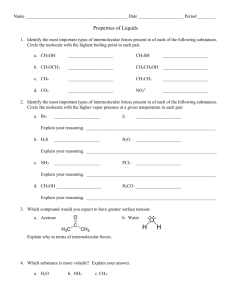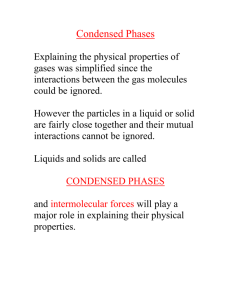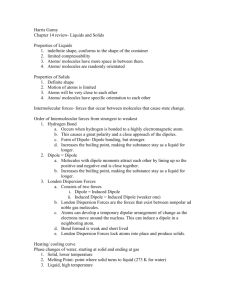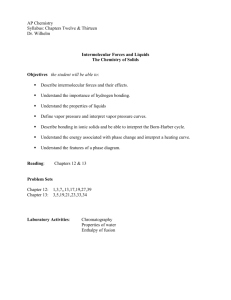CHAPTER 10: Liquids and Solids
advertisement
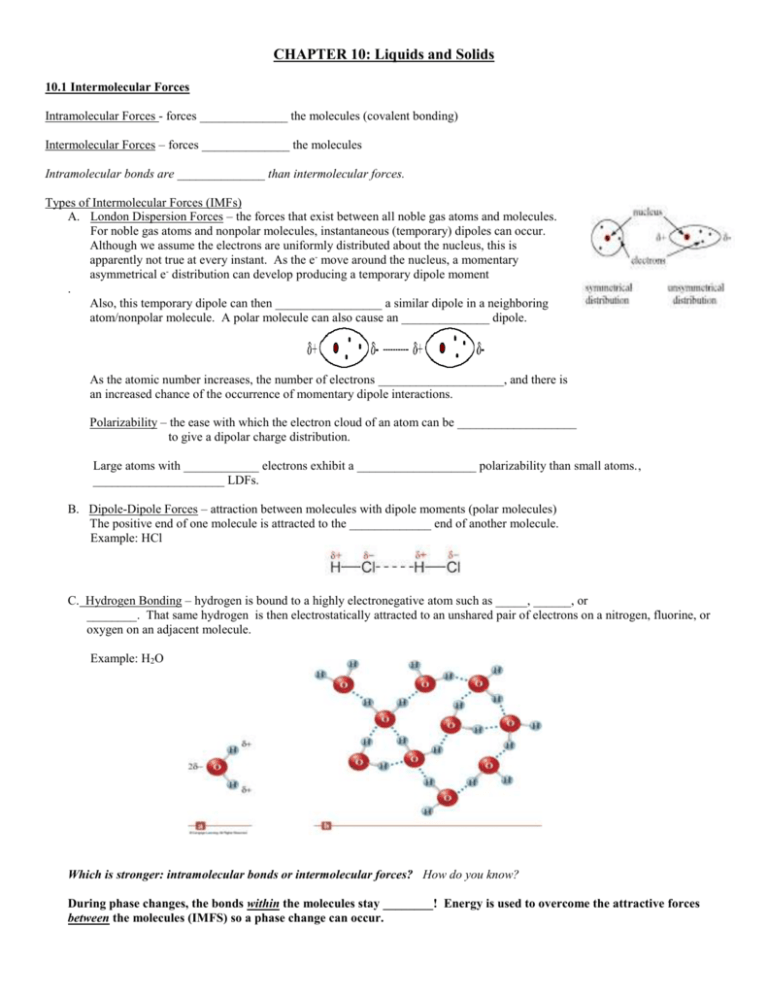
CHAPTER 10: Liquids and Solids 10.1 Intermolecular Forces Intramolecular Forces - forces ______________ the molecules (covalent bonding) Intermolecular Forces – forces ______________ the molecules Intramolecular bonds are ______________ than intermolecular forces. Types of Intermolecular Forces (IMFs) A. London Dispersion Forces – the forces that exist between all noble gas atoms and molecules. For noble gas atoms and nonpolar molecules, instantaneous (temporary) dipoles can occur. Although we assume the electrons are uniformly distributed about the nucleus, this is apparently not true at every instant. As the e- move around the nucleus, a momentary asymmetrical e- distribution can develop producing a temporary dipole moment . Also, this temporary dipole can then _________________ a similar dipole in a neighboring atom/nonpolar molecule. A polar molecule can also cause an ______________ dipole. As the atomic number increases, the number of electrons ____________________, and there is an increased chance of the occurrence of momentary dipole interactions. Polarizability – the ease with which the electron cloud of an atom can be ___________________ to give a dipolar charge distribution. Large atoms with ____________ electrons exhibit a ___________________ polarizability than small atoms., _____________________ LDFs. B. Dipole-Dipole Forces – attraction between molecules with dipole moments (polar molecules) The positive end of one molecule is attracted to the _____________ end of another molecule. Example: HCl C. Hydrogen Bonding – hydrogen is bound to a highly electronegative atom such as _____, ______, or ________. That same hydrogen is then electrostatically attracted to an unshared pair of electrons on a nitrogen, fluorine, or oxygen on an adjacent molecule. Example: H2O Which is stronger: intramolecular bonds or intermolecular forces? How do you know? During phase changes, the bonds within the molecules stay ________! Energy is used to overcome the attractive forces between the molecules (IMFS) so a phase change can occur. IMF Practice: 1) What type of IMFs are in the following: (a) Ar (b) NH3 (c) CO2 (d) CH3CH2CH3 2) Predict which substance in the following pair has the greater intermolecular forces and justify your answer. CH3OH or H2CO 10.2 The Liquid State Surface Tension – the resistance of a liquid to an ________________ in surface area. The stronger the intermolecular forces between liquid molecules, the ____________________ the surface tension. Cohesive forces – forces of attraction (IMFs) between molecules of a liquid. Viscosity – a measure of a liquid’s ________________________ to flow Viscosity increases with _________________ intermolecular forces and __________________ size. 10.3-10.7 Solids Two classifications of solids: Amorphous solids – Examples: Crystalline solids - Four categories of crystalline solids: Type of Solid Ionic Molecular Forces holding particles together in the solid Electrostatic Attraction m+ x- m+ xx- m+ x- m+ m+ x- m+ xHydrogen- Bonding Dipole- Dipole London Dispersion Forces Properties Examples High Melting Point (Related to lattice energy) Brittle, Hard, Nonconducting (solid state) Low Melting Point Nonconducting Metallic Metallic Bonding (electron sea) m+ e- m+ em+ e- m+ em+ e- m+ e- Variable Hardness and Melting Point (dependent on strength on metallic bond), Good Conductivity Covalent Network (Macromolecules) Covalent Bonding Very High Melting Points, Very Hard, Nonconducting Macromolecules – “giant” molecules. All atoms/molecules ______________________ bonded to each other. Metallic Solids Electron sea model – a regular array of cations in a “sea” of mobile valence electrons. The mobile electrons can conduct heat and electricity, and the metal ions can be easily moved around as the metal is hammered into a sheet (malleability) or pulled into a wire (ductility). METAL ALLOYS Alloy - a substance that contains a mixture of __________________ and has ________________________ properties. Substitutional alloy – some of the host atoms are ______________by another metal with atoms of ______________________ size. Ex: Brass In brass, approximately 1/3 of the host copper metal have been replaced by zinc atoms. Interstitial alloy – formed when some of the interstices (holes) in the lattice structure are occupied by ______________ atoms. Ex: Steel Steel contains ____________ atoms in the holes of an iron crystal. Pure iron is relatively soft, ductile, and malleable due to the absence of directional bonding. However, when carbon, which forms strong directional bonds, is introduced into the iron crystal, the resulting alloy is harder, stronger, and less ductile than pure iron. COVALENT NETWORK SOLIDS Many atomic solids contain strong directional covalent bonds to form a solid that might be best viewed as a “giant molecule.” Ex. The two most common forms of carbon, diamond and graphite, are covalent network solids Graphite( an allotrope of Carbon) has strong covalent bonding between the carbon atoms in the layers, which contribute to its high melting point. However, graphite is soft because adjacent layers can slide past each other relatively easily; the major forces of attraction between the layers are _______________. Ex. SiO2 Elemental silicon has the same structure as diamond; however, it is a metalloid and is a _________________________________. The small conductivity of silcon can be enhanced if the silicon crystal is _____________________ with certain other elements. Example #1-When a small fraction of silicon atoms is replaced by arsenic atoms, each having one ___________ valence electron than Si, __________ electrons become available for conduction. The result is a ____ -type semiconductor – conductivity is increased by doping it with atoms having more valence electrons than atoms in the host crystal. Example #2 – Silicon’s conductivity can also be enhanced by doping the crystal with an element such as boron, which has one _________ valence electron than Si. Because B has one _____ electrons than is required to form bonds with the surrounding Si atoms, an electron vacancy, or hole, is created . As an electron fills this hole, it leaves a new hole, and this process is repeated. This is an example of a ____ -type semiconductor, so named because the positive holes can be viewed as the charge carriers. 10.8 Vapor Pressure and Changes of State The change in state that occurs when the molecules of a liquid escape the liquid’s surface and form a gas is called _____________________________________ or ________________________________________. Vaporization is always __________________________________. The energy required to vaporize 1 mole of a liquid at a pressure of 1 atm is called the _______________________ ______________________________________, ∆Hvap. The process by which vapor molecules re-form a liquid is called __________________________________. Equilibrium – a state in which opposite processes are occurring at the same _____________________. Equilibrium vapor pressure – (commonly called the vapor pressure) – the pressure of vapor in equilibrium with its non-vapor phase (liquid or solid) The vapor pressures of liquids vary widely. Liquids with high vapor pressures are said to be __________________. These liquids have relatively _____________________ intermolecular forces. Liquids in which the IM forces are large (strong) have relatively _____________ vapor pressures. Example: At the same temperature, which liquid would have the lower vapor pressure and why- ethanol or water? Oil is nonpolar – why does it have a low vapor pressure? As temperature increases, the vapor pressure for a given liquid will ____________________________. Why? Changes of State – Heating Curve Heating Curve of Water: The temperature remains ____________________ during a phase change. The energy required to convert a mole of solid substance to a mole of liquid substance is called the _________________ ___________ _____________________, ∆Hfus. Normal boiling point - the temperature at which the vapor pressure of the liquid is exactly ____________ atm. Normal freezing point - the temperature at which the liquid and solid states have the same vapor pressure under conditions where the total pressure is _____________ atmosphere. In Leadville, Colorado, water boils at HOMEWORK ALL ASSIGNMENTS MUST BE DONE ON A SEPARATE SHEET OF PAPER! HOMEWORK 11/1 (INTERMOLECULAR FORCES) 1. What types of intermolecular forces are present in the following? (a) CH3Cl (b) NH3 (c) BF3 (d) Ne (e) HBr Which of the substances would have the highest boiling point? Which of the above substances would have the lowest boiling point? 2. Predict which substance in each of the following pairs would have the greater intermolecular forces and justify your answer! (a) CO2 or OCS (b) PF3 or PF5 (c) HF or HCl (d) SO3 or SO2 (e) N2 or Cl2 (f) CH3CH3 or CH3CH2OH HOMEWORK 11/4 (INTERMOLECULAR FORCES – CONT.) 1. Arrange the following in order of decreasing intermolecular forces: SO2, Cl2, CH3OH 2. Rationalize the difference in boiling points for each of the following pairs of substances. Justify your answer a) dimethyl ether, CH3-O-CH3 -25oC c) pentane 36.2oC ethanol, CH3CH2OH 79oC propane -42oC b) HCl LiCl -85oC 1360oC 3) In each of the following groups of substances, pick the one that has the given property. Justify your answer a) highest boiling point: HCl, F2, or Ar b) lowest freezing point: N2, CO, CO2 c) highest boiling point: HF, HCl, HBr 4) Which would have greater surface tension: N2 (l) or Br2 (l)? Explain why. 5) What type of solid (network, metallic, ionic, or molecular) will each of the following substances form: (a) SO2 (b) Ni (c) SiO2 (d) NH3 (e) Pt HOMEWORK 11/5 pp. 503-505 #15,38,42 Referring to the graph: Which liquid has the highest normal boiling point? Which liquid has the weakest intermolecular forces? HOMEWORK 11/6 – AP FRQ Using principles of chemical bonding and/or intermolecular forces, explain the following. Your answers must include reference to both substances. 1) The normal boiling point of H2S is much lower (-60oC) than the normal boiling point of H2O (100oC). 2) Si melts at a much higher temperature (1410oC) than Cl2 (-101oC). 3) MgO melts at a much higher temperature (2852oC) than NaF (993oC)


